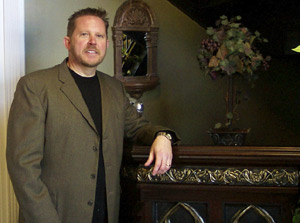 Garrett: “It’s about being honest and sharing the vision with the church.”
Garrett: “It’s about being honest and sharing the vision with the church.”Good Hope is a small church with a megachurch mentality.
Situated alongside a sleepy country road in southern Anderson County, a couple of miles outside of the small town of Iva, the once-traditional rural Baptist church has emerged from a five-year metamorphosis – from “three hymns and announcements” on Sunday mornings to worship gatherings punctuated with contemporary praise songs, drama and computer-driven graphics.
Along the way, the congregation has grown from less than 50 to about 250.
It has been a dramatic transformation for the church, but one that was handled tenderly, says pastor Robert Garrett.
“Before I came as pastor, I was pretty honest with the people,” said Garrett, 44, most of whose prior experience was with much larger churches. Assessing the situation at Good Hope, a church with “a reputation of being depressed,” Garrett told the pastor search committee that he was not interested in being a “maintenance-oriented” leader, but instead one who would “transition the church with change.”
The changes he saw as crucial for the church’s survival included everything from “the physical look of the place” to the kind of music used in worship.
“Of course I said all this very carefully,” Garrett said, “but I was honest with them. I didn’t tell them the whole picture, but I think it’s about being honest and sharing the vision with the church.”
Good Hope’s members embraced his vision. “They said, ‘If we don’t change, we’re not going to survive.'”
Garrett began implementing ideas based on his experiences working in other, larger congregations, including Grace Chapel Church in Denver, Col. He led the congregation through the South Carolina Baptist Convention’s “Thy Kingdom Come” self-study process, after which the church emerged with a vision statement.
One of the first big changes was the music program. Garrett led the church toward a more blended style that included both traditional hymns and contemporary music. Today, he says, the music is almost exclusively contemporary praise and worship. To his surprise, “the older folks were the ones who really encouraged us” with the transition in music style, something he admits is not always the case in a traditional church setting. “These are major issues for a church like this,” he said.
“We have lost very few older members because of the music,” he said. Garrett said the music has been a “big part” of attracting new families to the church.
Also part of the church’s vision plan was the construction of a multipurpose center, which has resulted in expanding Good Hope’s ministry opportunities, including providing flexible space for a revitalized student ministry program. The church also sponsored three NASCAR-themed fall festivals at nearby Crescent High School, attracting a thousand people – “a lot for our little community,” Garrett said.
The church’s prospect-visitation program has a catchy name: www.com (which stands for Welcome Watch Wagon for our Community). Yet another new ministry at Good Hope is Celebrate Recovery, a 12-step dependency recovery program pioneered by Rick Warren ministries.
Growth at Good Hope has not been without growing pains. Garrett said “a couple of people” left when the church posted directional signs that didn’t include the word Baptist. “We’re just trying to break down the walls and open it up to other people who might not be Baptist. We’re definitely Baptist in theology, and we’re Southern Baptist and always will be,” noting that the church has not dropped Baptist from its name.
When Garrett became Good Hope’s pastor, the 40 or so people in the congregation at the time were mostly senior adults. Today, he says the majority of people in his congregation are 30-50 years old, and the church’s student ministry serves about 45 teenagers. He also is pleased that most of the senior adults who were faithful to their church when he arrived are still there today.
“If I had come through here like a bull in a china closet and said, ‘My way or the highway,’ then it wouldn’t have worked. But I was blessed to have a number of strong mentors for ministry. I watched men and women navigate this ship very carefully.”
Garrett says he is mindful that church growth needs to be managed wisely. “I am one man wearing a lot of hats and with a lot of stokes in the fire,” he said, “so I’m learning to be very careful about how we do things.”